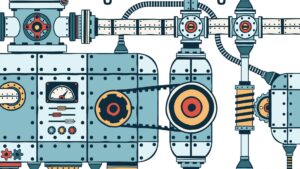In the vast realm of human innovation, there exist marvels that push the boundaries of engineering and technology, showcasing the pinnacle of human ingenuity. These extraordinary creations are the result of years of research, development, and collaboration among the brightest minds in various fields. In this article, we will delve into the world of the 10 most complex machines ever built, marveling at their intricacy and the impact they have had on science and industry.

- Large Hadron Collider (LHC):
At the forefront of particle physics, the Large Hadron Collider (LHC) stands as one of the most complex machines ever built by humanity. Situated at CERN, the European Organization for Nuclear Research, this colossal particle accelerator spans a circumference of 17 miles beneath the Swiss-French border. With the primary goal of unraveling the mysteries of the universe by studying subatomic particles, the LHC’s complexity lies not only in its massive size but also in the intricate coordination required to manipulate particles at near-light speeds.
The Large Hadron Collider has been pivotal in the discovery of the Higgs boson, a particle that contributes to our understanding of mass in the universe. Its significance in advancing our knowledge of fundamental physics makes it a standout example of a complex machine that has reshaped the landscape of particle physics.
- Space Launch System (SLS):
As humanity strives to explore the cosmos, the Space Launch System (SLS) emerges as a technological masterpiece. Developed by NASA, the SLS represents the most powerful rocket ever built, designed to propel spacecraft and astronauts beyond Earth’s orbit. Its complexity lies in its versatility, with the ability to carry payloads ranging from crewed missions to Mars to launching scientific probes deep into space.
The SLS incorporates cutting-edge propulsion systems, advanced materials, and intricate navigation technology. The collaboration required among aerospace engineers, scientists, and technicians to build and operate this colossal machine is a testament to human achievement in space exploration.
- ITER (International Thermonuclear Experimental Reactor):
Nuclear fusion, the process that powers the sun, holds the promise of clean and virtually limitless energy. The International Thermonuclear Experimental Reactor (ITER) is an ambitious global project aimed at achieving controlled nuclear fusion. Located in Southern France, ITER brings together contributions from 35 countries, making it one of the most complex international collaborations in the scientific realm.
The complexity of ITER lies in the intricacies of creating and maintaining conditions akin to those at the core of the sun, where hydrogen atoms fuse to release energy. The engineering challenges involved in confining and controlling superheated plasma, along with the international coordination required, make ITER a groundbreaking example of collaborative scientific efforts.
- The Human Genome Project:
Advancements in molecular biology and genetics have given rise to the Human Genome Project, an endeavor to map and understand the entire sequence of human DNA. The complexity of this machine lies not in physical size but in the enormity of the genetic code it seeks to unravel. This project involved scientists from around the world working collaboratively to sequence the approximately 3 billion base pairs of human DNA.
The Human Genome Project has paved the way for breakthroughs in personalized medicine, genetic counseling, and our understanding of hereditary diseases. Its impact on the field of genomics has been monumental, and the intricate science behind decoding the blueprint of human life places it among the most complex machines ever built.
- The Square Kilometre Array (SKA):
Peering into the cosmos with unprecedented precision, the Square Kilometre Array (SKA) represents the next frontier in radio astronomy. Spread across continents, the SKA is a vast network of radio antennas and dishes that collectively create a telescope with a collecting area of one square kilometer. This colossal machine is designed to probe the universe’s deepest mysteries, including the nature of dark matter and the origins of cosmic magnetism.
The complexity of the SKA lies in the synchronization of thousands of antennas spread across vast distances, processing massive amounts of data in real-time. As astronomers strive to answer fundamental questions about the cosmos, the SKA stands as a testament to the intricacy of modern astrophysical research.
- The International Space Station (ISS):
Orbiting 408 kilometers above Earth, the International Space Station (ISS) is a remarkable feat of engineering and international cooperation. Comprising multiple interconnected modules, laboratories, and solar arrays, the ISS serves as a microgravity research environment for scientific experiments and international collaborations in space exploration.
The complexity of the ISS is not only in its physical structure but also in the delicate balance required to sustain human life in space. The collaboration between space agencies from the United States, Russia, Europe, Japan, and Canada showcases the intricate nature of this orbiting laboratory, emphasizing humanity’s ability to overcome the challenges of living and working in the harsh environment of space.
- The Three Gorges Dam:
Majestically spanning the Yangtze River in China, the Three Gorges Dam is the world’s largest hydroelectric power station. This colossal engineering project stands as a testament to China’s determination to harness clean energy and control the flow of the mighty Yangtze River. The dam’s complexity lies in its massive scale, intricate design, and the numerous challenges associated with relocating communities and mitigating environmental impacts.
The Three Gorges Dam not only generates a significant portion of China’s electricity but also serves flood control and navigation purposes. Its construction required careful planning and execution, making it one of the most complex machines ever built on the planet.
- The Hubble Space Telescope:
Revolving around Earth at an altitude of approximately 547 kilometers, the Hubble Space Telescope has redefined our understanding of the universe. Launched in 1990, the Hubble has provided breathtaking images of distant galaxies, nebulae, and other celestial phenomena. Its complexity lies in the precise calibration of its instruments, intricate repair missions, and the continuous quest to push the boundaries of observational astronomy.
The Hubble Space Telescope has been instrumental in numerous scientific discoveries, from determining the rate of expansion of the universe to capturing detailed images of distant exoplanets. As a marvel of space technology, the Hubble exemplifies the intricate nature of observational astronomy.
- The Panama Canal:
Connecting the Atlantic and Pacific Oceans, the Panama Canal is a testament to human determination and engineering prowess. Completed in 1914, the canal facilitates the transit of ships through a series of locks and gates, overcoming the challenging topography of the Isthmus of Panama. The complexity of the Panama Canal lies in the intricate system of locks, channels, and gates that allow ships to traverse the 50-mile-long waterway.
The Panama Canal has been a vital artery for global trade, reducing travel distances and providing a shortcut for ships traveling between the Atlantic and Pacific. Its construction required overcoming challenging geological conditions and remains a landmark achievement in civil engineering.
- The Deep Underground Neutrino Experiment (DUNE):
Delving into the mysterious world of neutrinos, the Deep Underground Neutrino Experiment (DUNE) is a cutting-edge project hosted in the United States. Situated deep underground to shield it from cosmic rays, DUNE aims to unravel the secrets of neutrinos, elusive particles that hold the key to understanding the universe’s evolution.
The complexity of DUNE lies in its vast detectors, intricate data analysis, and the quest to capture rare neutrino interactions. The collaboration among scientists and engineers to design and construct this underground experiment exemplifies the intricate





